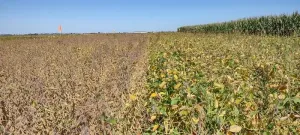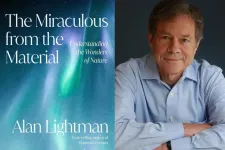AMES, Iowa – Over the typical two-year rotation of corn and soybeans most Iowa farmers use, 40% of nitrous oxide emissions are in the soybean year, according to a new study by an Iowa State University research team.
The share of the potent greenhouse gas released during the soybean half of a crop rotation cycle is surprisingly high, given most soybeans fields aren’t treated with nitrogen, said Michael Castellano, agronomy professor and William T. Frankenberger Professor of Soil Science at Iowa State University.
“We’ve just been assuming that legume crops like soybeans don’t have a big emissions footprint because they don’t usually receive fertilizer. But the natural processes in soil that produce nitrous oxide don’t stop just because you don’t apply fertilizer,” Castellano said. “Nearly half of our emissions in a typical cropping system come from soybeans, and we haven’t even been thinking about how to manage them.”
A team led by Castellano and postdoctoral researcher Tomas Della Chiesa hopes to change that. In a paper about the new analysis published this month in Nature Sustainability, they also shared modeling that shows planting winter cover crops in the fall and soybeans earlier in the spring could reduce emissions by one-third while increasing yields.
“My favorite part of this research is farmers are more likely to implement these solutions right away because they’re practical and scalable. The options already exist, but people just aren’t thinking about them in this way,” Castellano said.
An inherent challenge
In most industries, technology exists to slow or stop the release of heat-trapping gases causing climate change, such as carbon dioxide. Agriculture has a tougher and inherent challenge. Its greenhouse impact comes largely from methane and nitrous oxide, emissions that are difficult to curb because they’re biological byproducts. Livestock digestion is the biggest source of methane, while soil management is the main culprit for nitrous oxide.
“If you’re going to grow crops, there’s going to be some greenhouse gas emissions,” Castellano said.
It makes sense that most of the attention devoted to emissions from Corn Belt fields has been on optimizing nitrogen fertilizer usage, said Castellano, who also leads the Iowa Nitrogen Initiative, an ongoing research project to give Iowa farmers more precise data on ideal nitrogen rates. Properly managing fertilizer use is the essential first step in reducing emissions in corn-soybean systems and has other environmental benefits, such as improving water quality.
But fertilizer isn’t the only source of nitrous oxide in farming. When microbes break down organic matter in soil, some of the nitrogen produced converts into a gas form. Without plants to use the nitrogen generated in decomposition, bare soil gives off higher amounts of nitrous oxide – especially in the spring, when warmth and moisture encourage microbial activity. That’s what causes most soybean emissions.
“It’s coming from biochemical processes we can’t do anything to stop,” Della Chiesa said.
Limiting bare farmland
To quantify how much soybean farming contributes to the nitrous oxide output of the upper Midwest’s dominant crop rotation, Della Chiesa and Castellano analyzed data from 16 prior studies of corn-soybean systems. Finding that 40% of emissions came during the soybean half of the rotation heightens the need for a broader range of mitigation options, Della Chiesa said.
“We have to be thinking about management practices that aren’t related to fertilizer,” he said. “Half the year, we have bare soil.”
A strategy the researchers studied in their paper would drastically shorten the time farmland spends without living plants. Aerially sowing a winter cover crop of oats or rye into mature corn fields would cover soil with plants for the months between crops, and using an extended-growth soybean variety would allow earlier spring planting. The two-prong method would reduce soybean-year emissions by 33% and, with planting moved up about four weeks, increase yields by 16%, based on crop-system modeling.
Extended-growth soybeans are already widely available, and farmers are increasingly pushing soybean planting earlier. But they usually prioritize corn in the spring because corn yields are more affected by a late start than soybean yields. It helps that the U.S. Department of Agriculture in 2023 moved up by about a week the earliest planting date for soybeans covered by federal crop insurance. Soybeans in most of Iowa are covered if planted on or after April 15, while corn across Iowa and soybeans in southern Iowa are covered on or after April 10.
In the future, federal officials should consider the environmental benefits of setting earlier planting dates for insurance coverage, Castellano said.
“Our work suggests earlier planting has some value that should be incorporated when making those decisions,” he said.
What’s next?
The United Soybean Board provided the primary funding for the research and is also supporting a three-year follow-up study to field test the emissions and yield impact of combining a corn-following cover crop and earlier soybean planting, Castellano said. Results at experimental plots in Iowa, Illinois, Minnesota and Kentucky have been promising.
Other Iowa State research is seeking ways to capitalize on the advantages of earlier planting. Castellano and Matthew Hufford, a professor of ecology, evolution and organismal biology at Iowa State, are involved in a study exploring the emissions impact of earlier corn planting. And several Iowa State breeding experts are studying ways to genetically improve crops to be more tolerant of early-season cold.
No matter the approach, it’s crucial to identify ways to limit nitrous oxide production in agriculture, Castellano said. Though it currently represents a sliver of global greenhouse emissions, nitrous oxide on a pound-for-pound basis traps about 300 times more heat than carbon dioxide, and its relative influence on climate change will likely rise in the coming years.
“As we decarbonize other economic sectors, emissions from agriculture as a proportion of global emissions are expected go up rapidly because the mitigation opportunities are few and limited. So we need these reduction strategies,” Castellano said.
END





